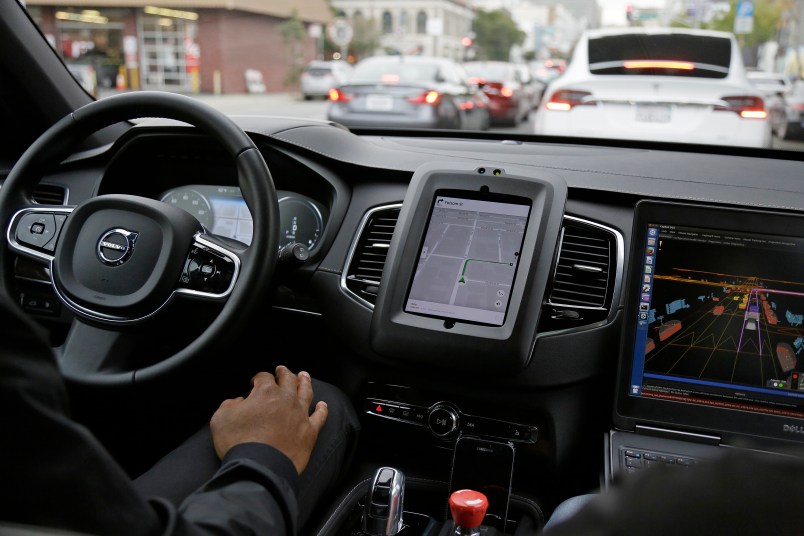SAN FRANCISCO (AP) — Uber is bringing a small number of self-driving cars to its ride-hailing service in San Francisco — a move likely to excite the city’s tech-savvy population and certain to antagonize California regulators.
The Wednesday launch in Uber’s hometown expands a public pilot program the company started in Pittsburgh in September. The testing lets everyday people experience the cars as Uber works to identify glitches before expanding the technology’s use in San Francisco and elsewhere.
California law, however, requires a test permit for self-driving prototype vehicles, and Uber does not have one. The company argues that the law doesn’t apply because its cars require a human backup.
Uber has a history of testing legal boundaries. Although the company has been around less than a decade, it has argued with authorities around the world about how much of its drivers’ histories should be covered in background checks and whether those drivers should be treated as contractors ineligible for employee benefits.
THE STREETS OF SAN FRANCISCO
Uber’s self-driving tests in San Francisco will begin with a “handful” of Volvo luxury SUVs — the company wouldn’t release an exact number — that have been tricked out with sensors so they can steer, accelerate and brake, and even decide to change lanes. The cars will have an Uber employee behind the wheel to take over should the technology fail. Users of the app may be matched with a self-driving car, but can opt out if they prefer a human driver. Self-driven rides cost the same as ordinary ones.
The cars will be put to the test in the congested streets of San Francisco. The city can be a daunting place to drive given its famously steep hills, frequent fog, street and cable cars, an active bicycle culture, and roads that are constantly being repaved, remarked and restricted for bike lanes and traffic management.
Uber believes its technology is ready to handle all this safely, though its executives concede the vehicles are nowhere near able to drive without a human ready to take control in dicey situations.
There was room for improvement during a Tuesday test drive attended by The Associated Press. The car was destined for a local pizza parlor, but didn’t pull directly in front of the restaurant, and instead stopped in the middle of the street. The cars may strike some riders as over-cautious, too. During the test drive, one idled in a traffic jam even though an adjacent lane was clear, prompting the human driver to make the move himself.
Uber’s fleet of Volvo XC90s won’t be the first self-driving cars on San Francisco streets — several other companies visit regularly with test prototypes, though none offers public rides.
Once testing is complete, the ultimate vision is to sell to the public technology which supporters argue will save thousands of lives because it doesn’t drink, text, fall asleep or take dangerous risks.
PERMIT ME NOT
Under state law, self-driving tests on public roads require a permit from the Department of Motor Vehicles. The department has issued permits to 20 companies, mostly a collection of traditional automakers and tech companies — but not Uber.
Uber argues that its cars aren’t really autonomous, and thus aren’t covered by the law. Under the law, an “autonomous vehicle” requires a permit if it can drive itself “without the active physical control or monitoring of a natural person.”
According to Anthony Levandowski, the leader of Uber’s self-driving program, Uber’s cars simply aren’t advanced enough to drive themselves without human monitoring. “We’re just not capable of doing that yet,” he said. Therefore, the Volvos are not autonomous and do not require a permit.
It makes no sense to get a permit when one is not needed, Levandowski said: “This is where science and logic needs to trump blind compliance.”
In a statement issued late Tuesday, the DMV said it “encourages the responsible exploration of self-driving cars” and noted that 20 companies have permits to test hundreds of cars in California.
“Uber shall do the same,” the statement said.
Operating without a permit arguably gives Uber a competitive advantage. Companies with one must report to the state all crashes and every instance in which a person takes control during testing. All that information is public. To receive a permit, a company must show proof of insurance, pay a $150 fee and agree that a human driver can take control of the vehicle.
Uber’s stance seems likely to upset both state officials and competitors, said Bryant Walker Smith, a law professor at the University of South Carolina who tracked California’s law as it was drafted in 2012. While an attorney could argue that Uber is reading the letter of California law correctly, Smith said, testing permits were “envisioned as a gateway, as an interim step” to launching self-driving cars on public roads.
Smith recalled discussing at the time the argument that Uber is now making: One day, a company might go public without a testing permit precisely because the law requires human oversight during testing.
___
Pritchard reported from Los Angeles. Contact him at https://twitter.com/lalanewsman . Liedtke can be reached at https://twitter.com/liedtkesfc
Copyright 2016 The Associated Press. All rights reserved. This material may not be published, broadcast, rewritten or redistributed.







This “self-driving car” dealio is weird and I approach it from several directions.
I can’t wait to upgrade my car to one with adaptive cruise and lane following, but I’m a good driver. Just like all of you are. Not like all those other idiots out there on the road.